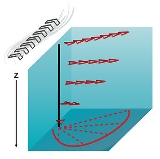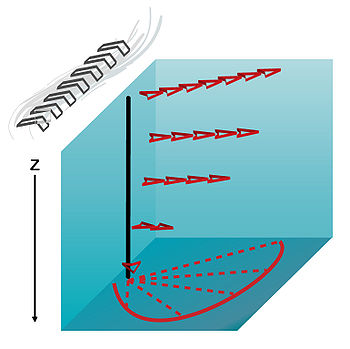
Ekman transport
Encyclopedia

Vagn Walfrid Ekman
Vagn Walfrid Ekman was a Swedish oceanographer.Born in Stockholm to Fredrik Laurentz Ekman, himself an oceanographer, he became committed to oceanography while studying physics at the University of Uppsala and, in particular, on hearing Vilhelm Bjerknes lecture on fluid dynamics.During the...
(for whom it is named), is the term given for the 90 degree net transport of the surface layer (depth to which wind penetrates) due to wind forcings. This phenomenon was first noted by Fridtjof Nansen
Fridtjof Nansen
Fridtjof Wedel-Jarlsberg Nansen was a Norwegian explorer, scientist, diplomat, humanitarian and Nobel Peace Prize laureate. In his youth a champion skier and ice skater, he led the team that made the first crossing of the Greenland interior in 1888, and won international fame after reaching a...
, who recorded that ice transport appeared to occur at an angle to the wind direction during his arctic expedition
Nansen's Fram expedition
Nansen's Fram expedition, 1893–1896, was an attempt by the Norwegian explorer Fridtjof Nansen to reach the geographical North Pole by harnessing the natural east–west current of the Arctic Ocean...
during the 1890s. The direction of transport is dependent on the hemisphere. In the northern hemisphere
Northern Hemisphere
The Northern Hemisphere is the half of a planet that is north of its equator—the word hemisphere literally means “half sphere”. It is also that half of the celestial sphere north of the celestial equator...
this transport is at a 90 degree angle to the right of the direction of the wind, and in the southern hemisphere
Southern Hemisphere
The Southern Hemisphere is the part of Earth that lies south of the equator. The word hemisphere literally means 'half ball' or "half sphere"...
it occurs at a 90 degree angle to the left of the direction of the wind.
Theory
Ekman theory explains the theoretical state of circulation if water currents were driven only by the transfer of momentum from the wind. In the physical world this is difficult to observe due to the presence of many other currentOcean current
An ocean current is a continuous, directed movement of ocean water generated by the forces acting upon this mean flow, such as breaking waves, wind, Coriolis effect, cabbeling, temperature and salinity differences and tides caused by the gravitational pull of the Moon and the Sun...
driving forces (i.e. pressure
Pressure
Pressure is the force per unit area applied in a direction perpendicular to the surface of an object. Gauge pressure is the pressure relative to the local atmospheric or ambient pressure.- Definition :...
and density gradients
Density Gradient
Density gradient is a spatial variation in density over an area. The term is used in the natural sciences to describe varying density of matter, but can apply to any quantity whose density can be measured...
). Though the following theory technically applies to this ideal situation in which only wind drives circulation, Ekman motion describes the wind driven portion of surface circulation seen in the surface layer.
Surface currents flow at a 45 degree angle to the wind due to a balance between the Coriolis
Coriolis effect
In physics, the Coriolis effect is a deflection of moving objects when they are viewed in a rotating reference frame. In a reference frame with clockwise rotation, the deflection is to the left of the motion of the object; in one with counter-clockwise rotation, the deflection is to the right...
force and the drags
Drag (physics)
In fluid dynamics, drag refers to forces which act on a solid object in the direction of the relative fluid flow velocity...
generated by the wind and the water. If the ocean is divided vertically into thin layers, the magnitude of the velocity (the speed) decreases from a maximum at the surface until it dissipates. The direction also shifts slightly across each subsequent layer (right in the northern hemisphere and left in the southern hemisphere). This is called the Ekman spiral
Ekman spiral
The Ekman spiral refers to a structure of currents or winds near a horizontal boundary in which the flow direction rotates as one moves away from the boundary. It derives its name from the Swedish oceanographer Vagn Walfrid Ekman...
. The layer of water from the surface to the point of dissipation of this spiral is known as the Ekman layer. If all flow over the Ekman layer is integrated, the net transportation is at an angle of 90 degrees to the right (left) of the surface wind in the northern (southern) hemisphere.
Mathematical derivation
Some assumptions of the fluid dynamics involved in the process must be made in order to simplify the process to a point where it is solvable. The assumptions made by Ekman were:- No boundaries
- Infinitely deep water
- Eddy viscosity,
 , is constant (this is now known not to be totally true)
, is constant (this is now known not to be totally true)
- The wind forcing is steady and has been blowing for a long time
- BarotropicBarotropicIn meteorology, a barotropic atmosphere is one in which the pressure depends only on the density and vice versa, so that isobaric surfaces are also isopycnic surfaces . The isobaric surfaces will also be isothermal surfaces, hence the geostrophic wind is independent of height...
conditions with no geostrophic flow
- The Coriolis parameter,
 is kept constant
is kept constant
The simplified equations for the Coriolis force in the x and y directions follow from these assumptions:
1)

2)

where
 is the wind stress,
is the wind stress,  is the density,
is the density,  is the East-West velocity, and
is the East-West velocity, and  is the north-south velocity.
is the north-south velocity.Integrating each equation over the entire Ekman layer
3)

4)

where
5)

6)

Here
 and
and  represent the zonal and meridional mass transport terms with units of mass per unit time per unit length. Contrarily to common logic, north-south winds cause mass transport in the East-West direction.
represent the zonal and meridional mass transport terms with units of mass per unit time per unit length. Contrarily to common logic, north-south winds cause mass transport in the East-West direction.In order to understand the vertical velocity structure of the water column, equations 1 and 2 can be rewritten in terms of the vertical eddy viscosity term.
7)

8)

where
 is the vertical eddy viscosity coefficient
is the vertical eddy viscosity coefficientThis gives a set of differential equations of the form
9)

10)

In order to solve this system of two differential equations, two boundary conditions can be applied:
 as
as 
- Friction is equal to wind stress at the free surface (
 )
)
Things can be further simplified by considering wind blowing in the y-direction only. This means is the results will be relative to a north-south wind (although these solutions could be produced relative to wind in any other direction):
11)

12)

where
 and
and  represent Ekman transport in the u and v direction
represent Ekman transport in the u and v direction
- In equation 11 the plus sign applies to the northern hemisphere and the minus sign to the southern hemisphere.
 is the wind stress on the sea surface
is the wind stress on the sea surface
 is the Ekman depth (depth of Ekman layer)
is the Ekman depth (depth of Ekman layer)
By solving this at z=0, the surface current is found to be (as expected) 45 degrees to the right (left) of the wind in the Northern (Southern) Hemisphere. This also gives the expected shape of the Ekman spiral, both in magnitude and direction. Integrating these equations over the Ekman layer shows that the net Ekman transport term is 90 degrees to the right (left) of the wind in the Northern (Southern) Hemisphere.
Applications
- Ekman transport is a factor in coastal upwelling regimes which provide the nutrient supply for some of the largest fishing markets on the planet. Wind in these regimes blows parallel to the coast (such as along the coast of PeruHumboldt CurrentThe Humboldt Current , also known as the Peru Current, is a cold, low-salinity ocean current that flows north-westward along the west coast of South America from the southern tip of Chile to northern Peru. It is an eastern boundary current flowing in the direction of the equator, and can extend...
, where the wind blows North). From Ekman transport, surface water has a net movement of 90 degrees to the left in such a location. Because the surface water flows away from the coast, the water must be replaced with water from below. It is important to remember that in shallow coastal waters, the Ekman spiral is normally not fully formed and the wind events that cause upwelling episodes are typically rather short. This leads to many variations in the extent of upwelling, but the ideas are still generally applicable.
- Ekman transport is similarly at work in equatorial upwelling, where, in both hemispheres, a trade windTrade windThe trade winds are the prevailing pattern of easterly surface winds found in the tropics, within the lower portion of the Earth's atmosphere, in the lower section of the troposphere near the Earth's equator...
component towards the west causes a net transport of water towards the pole, and a trade wind component towards the east causes a net transport of water away from the pole.
- On smaller scales, cyclonicCycloneIn meteorology, a cyclone is an area of closed, circular fluid motion rotating in the same direction as the Earth. This is usually characterized by inward spiraling winds that rotate anticlockwise in the Northern Hemisphere and clockwise in the Southern Hemisphere of the Earth. Most large-scale...
winds induce Ekman transport which causes net divergence and upwelling, or Ekman pumping, while anti-cyclonicAnticycloneAn anticyclone is a weather phenomenon defined by the United States' National Weather Service's glossary as "[a] large-scale circulation of winds around a central region of high atmospheric pressure, clockwise in the Northern Hemisphere, counterclockwise in the Southern Hemisphere"...
winds cause net convergence and downwelling, or Ekman suction
- Ekman transport is also a factor in the circulation of the ocean gyres. Ekman transport causes water to flow toward the center of the gyre in all locations, creating a sloped sea-surface, and initiating geostrophic flow (Colling p 65). Harald SverdrupHarald SverdrupHarald Ulrik Sverdrup was a Norwegian oceanographer and meteorologist who made a number of important theoretical discoveries in these fields. Having first worked in Bergen and Leipzig he was the scientific director of the North Polar expedition of Roald Amundsen aboard the Maud from 1918 to 1925...
applied Ekman transport while including pressure gradient forces to develop a theory for this (see Sverdrup balanceSverdrup balanceThe Sverdrup balance, or Sverdrup relation, is a theoretical relationship between the wind stress exerted on the surface of the open ocean and the vertically integrated meridional transport of ocean water.- History :...
).


